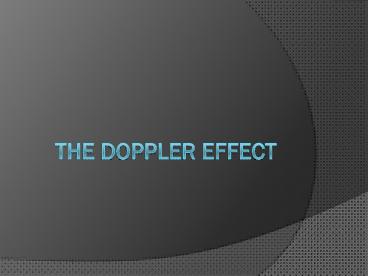The Doppler Effect - PowerPoint PPT Presentation
1 / 21
Title:
The Doppler Effect
Description:
Frequency of car horn remains the same, the wave fronts reach an observer in ... Find the speed of a police car racing down the road with his siren emitting a ... – PowerPoint PPT presentation
Number of Views:93
Avg rating:3.0/5.0
Title: The Doppler Effect
1
The Doppler Effect
2
Spherical and Plane Waves
- Sound emanates from a source in all directions at
the same speed (assuming medium is constant
everywhere), and therefore takes the shape of
concentric spheres for the wave fronts. - At large distances from the source these wave
fronts can be regarded as plane waves.
3
Spherical Wave
4
Spherical into Plane Waves
5
Doppler Effect
- Experienced whenever there is relative motion
between a source of waves and an observer.
6
What is happening at A and B?
7
Relative Motion
- When source and observer are moving toward each
other, observer hears a frequency higher than
source frequency. - When source and observer are moving away from
each other, observer hears a lower frequency.
8
Relative motion towards
- Frequency of car horn remains the same, the wave
fronts reach an observer in front of the car more
often than they would if the car were stationary. - During motion towards each other, observer
detects an additional number of wave fronts.
9
Relative motion away
- The wave fronts reach the observer behind the car
less often than they would if the source were
stationary. - When observer and source are traveling away from
each other, fewer wave fronts are detected per
second.
10
Source Moving Toward Stationary Observer
- f f / (1 vs/v)
- f perceived frequency
- f actual frequency
- vs speed of source
- v speed of sound
11
Source Moving Away from Stationary Observer
- f f / (1 vs/v)
- f perceived frequency
- f actual frequency
- vs speed of source
- v speed of sound
12
Observer Moving Toward Stationary Source
- f f (1 vo/v)
- f perceived frequency
- f actual frequency
- vo speed of observer
- v speed of sound
13
Observer Moving Away from Stationary Source
- f f (1 vo/v)
- f perceived frequency
- f actual frequency
- vo speed of observer
- v speed of sound
14
If Both are Moving
- If they are moving toward each other
- f f (1 vo/v) / (1 vs/v)
- If they are moving away from each other
- f f (1 - vo/v) / (1 vs/v)
15
Example Problem
- A train moving at a speed of 40.0 m/s sounds its
whistle, which has a frequency of 500 Hz.
(a) Determine the frequency heard by a stationary
observer as the train approaches the observer.
(b) as the train passes and is leaving the
observer.
16
Example Problem II
- An ambulance travels down a highway at a speed of
40.0 m/s, its siren emitting sound at a frequency
of 400 Hz. What frequency is heard by a
passenger in a car traveling at 30.0 m/s in the
opposite direction as the car (a) approaches? (b)
moves away from the ambulance? (take the speed
of sound to be 345 m/s)
17
Example Problem III
- Find the speed of a police car racing down the
road with his siren emitting a frequency of 400
Hz if a stationary observer hears an observed
frequency of 440 Hz. (take speed of sound to be
345 m/s)
18
Doppler Effect for Light
19
Mach number
- What happens as the source speed approaches the
speed of sound? - What happens when the source speed becomes
greater than the speed of sound? - Ratio of source speed to sound wave speed is mach
number.
20
Sonic Boom!
- As source exceeds the wave velocity, a conical
wave front is produced (shock wave)
21
Shock Wave































